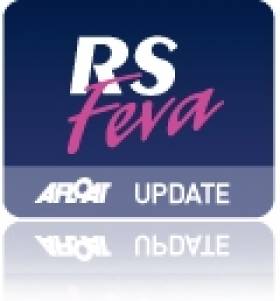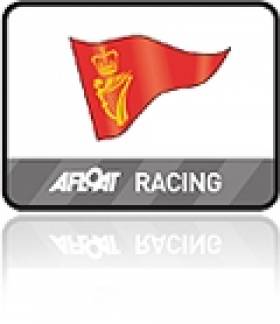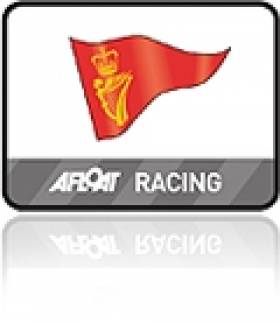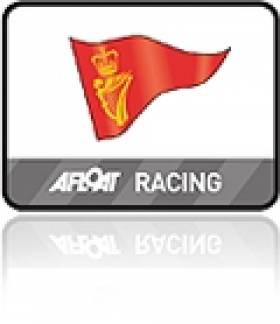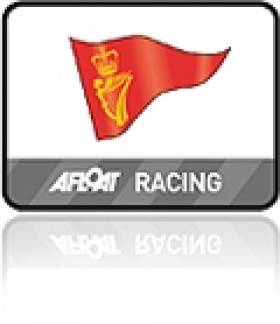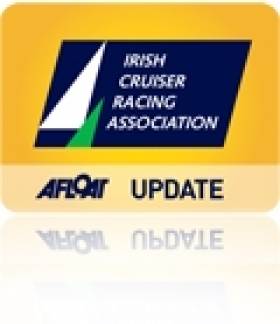Displaying items by tag: Royal Cork
Local Duo Take Feva National Title in Cork Harbour (Photos here)
Nine races were set over three days by Race Officer Richard Leonard, with racing mainly on the Curlane bank. Despite challenging visibility on the first day, racing conditions were good all weekend, with winds strong, but not overpowering. RCYC boats perfomed strongly in their home waters, taking the first three podium positions.
In the Gold Fleet, Whitaker and McGinley led from the outset, holding first position from day 1. Sean O'Brien and Louise Shanahan, RCYC took first place in the Silver Fleet. First Girl was won by Greystones SC duo Lisa Smith and Kate Hayes.
An extra race was held on the second day, Saturday, resurrecting an old tradition of a crew's race back to the Royal Cork Yacht Club. The crews race was won by 11 year old Sarah Cudmore, RCYC.
RESULTS
Gold Fleet:
1st David Whitaker, Jil McGinley (RCYC), 10pts;
2nd Marc Cudmore, Sarah Cudmore (RCYC), 24pts;
3rd Sam McGinley, Richard McGinley (RCYC), 27pts;
4th David Johnston, Louise Flynn Byrne (Howth YC), 31pts;
5th Seafra Guilfoyle, Philip Brownlow (RCYC), 33pts.
Silver Fleet:
1st Sean O'Brien, Louise Shanahan (RCYC)
2nd Ciara Byrne, Megan Hayes (Greystones SC)
3rd Blaithnaid O'Connell, Rosanna Cassidy, (RSTGYC)
First Girl Helm: Lisa Smith and Kate Hayes (Greystones SC)
U13 Winner: Jamie Tingle, Criofan Guilfoyle (RCYC)
U14 Winner: Nicky Delamer, Conor Howard (Howth YC)
U15 Winner: Dermot Lyden, Brian Stokes (RCYC/BSC)
Cavatina is White Sail Winner
The breeze came from a Westerly direction at 6 to 10 knots. The start was about 2 hours after high water. It was a gentle evening sail. The Race Officer Jim Sheeran managed to get everybody over the finish line despite the dying breeze.
Results Summary:
1st in White Sail IRC Ian Hickey's Granada 38 "Cavatina"
1st in White Sail Echo Micheal Lynch's Sun Odyssey 32i "Lady T"
1st in Class 3 IRC & Echo Jimmy Nyhan & Maritta Buwalda's 1/4 Tonner "Outrigger"
1st in Class 2 IRC & Echo Denis Coleman's Corby 25 "Thunderbird"
1st in Class 1 IRC & Echo Donal O'Leary's X35 "D-Tox"
Tux Wins First Race of Royal Cork's 'O'Leary Insurance' League
The breeze was coming from the North West at 12 knots with gusts up to 20 knots. The start was about 3 hours after low water.
The youngest (at the age of three) Race Officer in the Royal Cork was Alex O'Connell, ably assisted by his Father Kieran. They set an excellent course (No.99). Which kept the crews busy with all points of sailing. The fleet was a bit lighter than usual because a number of boats were competing in Calves Week.
Here is last night's results summary:
1st in White Sail IRC Ian Hickey's Granada 38 "Cavatina"
1st in White Sail Echo Micheal Lynch's Sun Odyssey 32i "Lady T"
1st in Class 3 IRC Paul Murray's Impala "Prometheus"
1st in Class 3 Echo John & Fiona Murphy's Impala "Fastbuck"
1st in Class 2 IRC Ted Crosbie's X302 "No Excuse"
1st in Class 2 Echo Leonard Donnery's Nicholson 33 "No Gnomes"
1st in Class 1 IRC & Echo Mary O'Keefe's X332 "Tux"
No Excuses for Overall Winner Crosbie in IRC 2
To top the evening off, it was nice to see the National 18 crews enjoying themselves outside the Club Bar (after a busy day of racing) while we were motoring up the river!
On the results front:
White Sail IRC Tom McNiece's Sigma 33 "Minx 111" got the number 1 slot last night and also got first in the League.
White Sail Echo Micheal Lynch's Sun Odyssey 32i "Lady T" got the number 1 slot last night and also first in the League.
Class 3 IRC Jimmy Nyhan & Maritta Buwalda's 1/4 tonner "Outrigger" got the four bullets in the League including last night, what a performance! They were also first overall in Echo.
Class 3 Echo Paul Murray's Impala "Prometheus" got the number 1 slot last night.
Class 2 IRC Ted Crosbie's X302 "No Excuse" had an excellent race last night coming first and first overall.
Class 2 Echo Derry Nash's First 31.7 "Catalpa" came first overall.
Class 2 Echo Mark Mendell's Sun fast 32 "Wicked" got the number 1 slot last night
Class 1 IRC Kieran Twomey's Corby "Gloves Off" came first overall.
Class 1 IRC Donal O'Leary's X35 "D-Tox" got the number 1 slot last night.
Class 1 Echo Frank Doyle's A35 "End Game" came first overall.
Class 1 Echo Aidan Heffernan's Dehler 36 "Indulgence" got the number one slot last night.
Largest Ever Fleet of National 18s Assemble at RCYC
It was decided to give the fleets a long start line to cater for the differing speeds of the categories of 18s involved. A south west breeze of some 12 knots made for nice sailing and there was plenty of close competition as the boats rounded the weather and spreader marks.
For the racing proper starting tomorrow the fleets will be split with the Classics FG at 11am and will sail round the cans courses with plans to have the morning races finished in time to visit the local hospitality centres. The Ultimate fleet will start racing at FG 11.30am and it is expected that, weather permitting, they will sail outside the harbour.
Dillon's Silk Breeze in Top Form in Cork Harbour IRC
The breeze was coming from the South West at about 10 knots. Full mains and a light No.1 for the seond race of the Timberland league. The start was an hour and a half after high water. So the spring tide made tactics more interesting. The Race Officers, once again set an excellent course. It was a clean start for everyone with a short beat from Corkbeg to the Cage which we left to port. We then reached out to No.3 and then another beat out to W2. It was then a bear away set for a Spinnaker up the harbour leaving No.6 to port on the way to No.5 otherwise known as Dognose. Short beat once again to the Cage with another bear away set to No.9 After that we had another beat back to Dognose and a short beat then to the finish. It was a proper summer evening race thanks to the Race Officers and the Weather Gods!
Ernie Dillon's "Silk Breeze" in White Sail got the number 1 slot in IRC and 2nd in Echo. In Class 3 it went to Jimmy Nyhan & Maritta Buwalda's 1/4 tonner "Outrigger" in both IRC & Echo, in Class 2 it was Kieran & Liz O'Briens MG335 "Magnet" that came 1st in IRC & 2nd in Echo and in Class 1 the honours went to the Corby "Gloves Off" Kieran Twomey.
Four Oppy Fleets Take to the Water in Crosshaven
Racing Round Up: Lasers, E Boats, Puppeteers,DBSC, VDLR, Royal Cork, Cove and Sailor of the Month
In Cork Harbour 'Mid-Summer Madness' regatta attracted 40 Boats. We have the photos. There was a Fun Time for Cruisers at Cove Sailing Club's 'At Home' Regatta.
Galway's Martin Breen is June's Sailor of the Month and the Waterford Tall Ships Parade of Sail Photos are here.
Reasons to be cheerful? You bet. Click here to read how Dublin Bay sailors celebrate these wins.
Thistle Takes Cork Harbour Race
Peter Webster's Hustler 25 'Thistle' was first home in last night's White Sail Division of Royal Cork's Union Chandlery June league.
Cork Harbour racing last night started an hour after low water. Winds were north–westerly averaging 12 knots with a few surprise gusts.
The fleet was somewhat depleted for the June League, because a number of the boats were competing in Kinsale for the Sovereign's Cup.
In Class three first place went to John and Fiona Murphy's Impala 28 'Fast Buck', in Class 2 it was Kieran and Liz O'Brien's MG335
'Magnet' and in Class 1 it was Mary O'Keefe's X332 'Tux'.
The ICRA Nationals were a great success in Royal Cork Yacht Club last weekend building on the integrity of the previous events writes ICRA Chief Barry Rose.
The conditions were sparkling with two tough days sailing followed by a peach of a day on Sunday in blue skies flat seas and 7/10 knots of breeze to finish off in Carribean style.
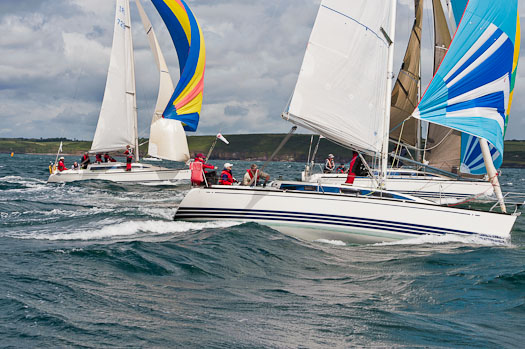
Carribbean sailing, Cork Harbour style. Photo: Bob Bateman
After Friday's tricky opener in big swells and shifty breeze many competitors throught Saturday's blast in mostly winds ranging 20 to 30 knots was as exciting and tough a days sailing as they could remember. Pics HERE. The race officers Peter Crowley and Richard Leonard laid super courses and got in a full programme. Results and overall winner pics here.
There was real quality through the fleets and representation from every Coast in Ireland from Northern Ireland, UK, Wales and New Zealand giving the event an International feel.
The Royal Cork provided its usual warm welcome and good organisation on and off the water.
A top class buffet was attended by 180 people on Saturday night and sailors danced to samba music until the early hours.
The Dubarry Brass Boot Special award was presented to the New Zealand team on Black Fun for making the effort to ship their boat and travel so far.
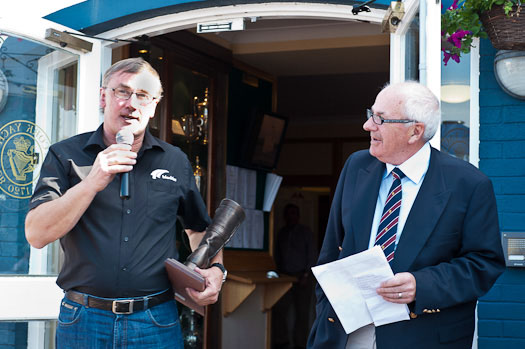
Irish crews gave visitors the boot, on and off the water. Photo: Bob Bateman
The Dubarry and ICRA formula to award day prizes to all crews on winning boats was a welcome recognition that sailing is a team sport and the system where each boat could only win 1 set of crew prizes saw these day prizes spread around to good effect.
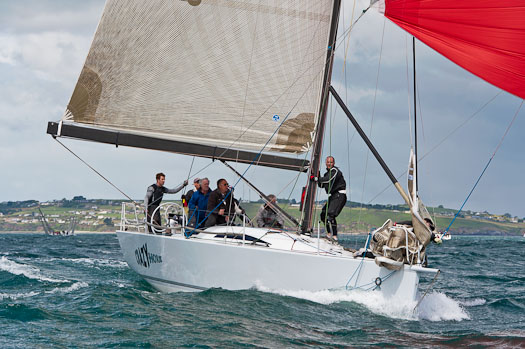
Long way from home. Dublin visitors got a great welcome. Photo: Bob Bateman
The last ingredient in the event was the amazing value for money with a 120 Euro entry fee including a week on the Royal Cork marina, a 100 Euro lift in and out offer and an accomodation deal with Hotel partners the Carrigaline Court of 130 Euros B and B for 4 days and 1 dinner was hugely appreciated and enjoyed by competitors.

Happy campers - on site parking facility at the club. Photo: Robert Bateman
A free bus down each morning and home made burger and chips and a beer for 10 Euro after sailing were nice details that all went down well.

The hooded sportsboat, another Cork Harbour invention. Photo: Bob Bateman
The prize giving on the deck in the Royal Cork in the sun saw Crosshaven at its best. ISA President Niamh Mc Cutcheon presented the medals and Vice Adrmiral Peter Deasy the trophies. They were assisted by Chairman of the organising Committee Rear Admiral Ronan Enright and ICRA administered the proceedings with Commodore Barry Rose Secretary Denis Kielly and treasurer and former Commodore Fintan Cairns. Prize giving pics HERE.
Those who did not attend missed a cracker of a Championship and those who won National titles thoroughly deserved them for the variety of conditions they encountered and the skill and standard to which they sailed.



























